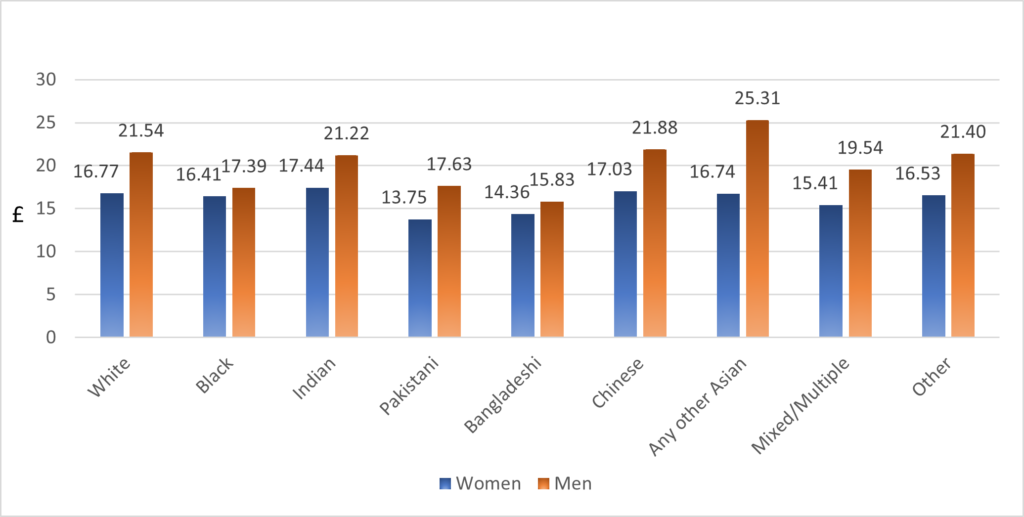
In this blog, Dr Kostas Kollydas sheds light on the factors influencing wage disparities by ethnicity in the UK labour market and discusses policy implications.
Ethnicity as a Social Construct
Ethnicity is a social organisation concept and is frequently used to classify people based on whether they share a perception of specific characteristics (such as language, religious connections, history, values, customs and beliefs, cultural distinctiveness, geographical origin, and race). In sociological literature, it has been argued that ethnicity is the result of a social process that develops and changes over time, as opposed to merely being an attribute acquired at birth. Ethnicity is thus considered more subjective than race, which is closely associated with skin colour and nationality.
In the decades prior to the 1991 Census, UK residents were classified based on the Commonwealth country in which they were born (during the 1960s), their White or “coloured” appearance (1970s), and their broad national group membership (1980s). For the first time, the 1991 Census introduced an ethnicity question based on self-identification, which was subsequently utilised in numerous government surveys and research studies. The following Censuses modified this question and revised the ethnic categories classification to accommodate the rapidly changing and ethnically diverse population of the UK. Specifically, the percentage of non-White people in England and Wales has increased from 7% in 1991, to 9% in 2001, 14% in 2011, and 18% in 2021. Of the total 2021 population in England and Wales (59.6 million), 82% identified as “White” (including “White British” at 74%), 9% as “Asian/Asian British/Asian Welsh”, 4% as “Black/African/Caribbean/Black British/Black Welsh”, and 5% as “Mixed” or “Other” ethnicity.
Ethnic pay disparities persist even amongst the highly educated employees
As part of my PhD research at the University of Bath, I explored ethnic pay inequalities in the UK labour market. I chose to focus on working-age university graduates in recognition of the rapid increase in participation rates in higher education over time and the vital role graduates play in the skills ecosystem. Moreover, concentrating on people who were born in the UK helped make more robust comparisons by reducing the effect of factors that are not observed in administrative data but are likely to disproportionately influence wages among ethnic groups born in the UK compared to first-generation immigrants (e.g. language skills, knowledge of local labour markets, social assimilation, differences in curricula across countries, and so forth). The graph below depicts gender- and ethnicity-based wage disparities between UK-born graduates. On average, certain ethnic minority graduates (most notably Black, Pakistani, and Bangladeshi employees) earn less than their White counterparts, whereas Indian and Chinese graduates are among the highest-paid minorities. In addition, women are paid less than men across all ethnic groups, most likely reflecting the well-established gender income inequalities and disparities in professional choices between genders.
Hourly wages (£) by ethnicity and gender among university graduates born in the United Kingdom

Source: Annual Population Survey pooled data from 2013 to 2018. “Office for National Statistics, Social Survey Division (2020). Annual Population Survey, 2004-2019: Secure Access. [data collection]. 15th Edition. UK Data Service.”
How could ethnic pay inequalities be addressed?
In 2022, the UK government accepted the Commission on Race and Ethnic Disparities’ recommendation that “ethnicity pay gaps should continue to be reported on a voluntary basis” in response to the consultation launched in 2018 on whether organisations that already report gender pay gaps should be required to report ethnic pay gaps as well. The reasons for this decision stem from employers’ incomplete data on ethnicity and the fact that, unlike in the case of gender, applying a binary ethnic disaggregation would obscure existing differences within major ethnic groups. For example, the non-White category includes specific groups (such as Indian and Chinese people) that are paid significantly more than others (e.g. Black or Pakistani people). In addition, the proportion of ethnic minorities in certain parts of the UK is very low, thereby preventing meaningful (and statistically significant) comparisons from being drawn from the ethnicity pay reporting. Nonetheless, some large employers already voluntarily report disparities in pay based on ethnicity.
Policymaking and anti-discrimination initiatives should centre on reducing wage disparities by encouraging employers to provide equal opportunities in the workplace. Businesses that practice fair treatment towards ethnic minorities could be rewarded with tax benefits, for instance. In addition, to shrink inequalities in earnings between ethnic groups, actions should be taken to remove barriers that prevent minority employees from accessing higher-paying jobs and industries. One likely way to achieve this is by setting quotas (while considering their limitations) for the minimum proportion of non-White employees at each company, particularly in leadership and professional positions, to promote diversity. Employers could also diversify their recruitment personnel to increase the chances of hiring employees from ethnic minority groups and to encourage more individuals from these groups to apply for jobs. Similarly, having more non-White leaders and executives can serve as role models and mentors, and inspire ethnic minorities to strive for higher positions. Employers should also assess the efficacy of their equal treatment policies to understand why they might not be working in practice.
Population projections indicate that the share of ethnic minorities will continue to rise in the future, suggesting that if ethnic disparities in the labour market are not addressed, this issue will affect a growing number of people, with repercussions for inclusive growth and levelling up agendas. It goes without saying that all employees, regardless of their characteristics and backgrounds, should be treated fairly. This is reflected in current UK legislation and its economic significance is supported by a previous analysis estimating a benefit of £24 billion annually (1.3% of GDP) if ethnic minorities achieve full representation in the UK labour market.
This blog was written by Dr Kostas Kollydas, Research Fellow at City-REDI / WMREDI, University of Birmingham.
Disclaimer:
The views expressed in this analysis post are those of the authors and not necessarily those of City-REDI / WMREDI or the University of Birmingham.
